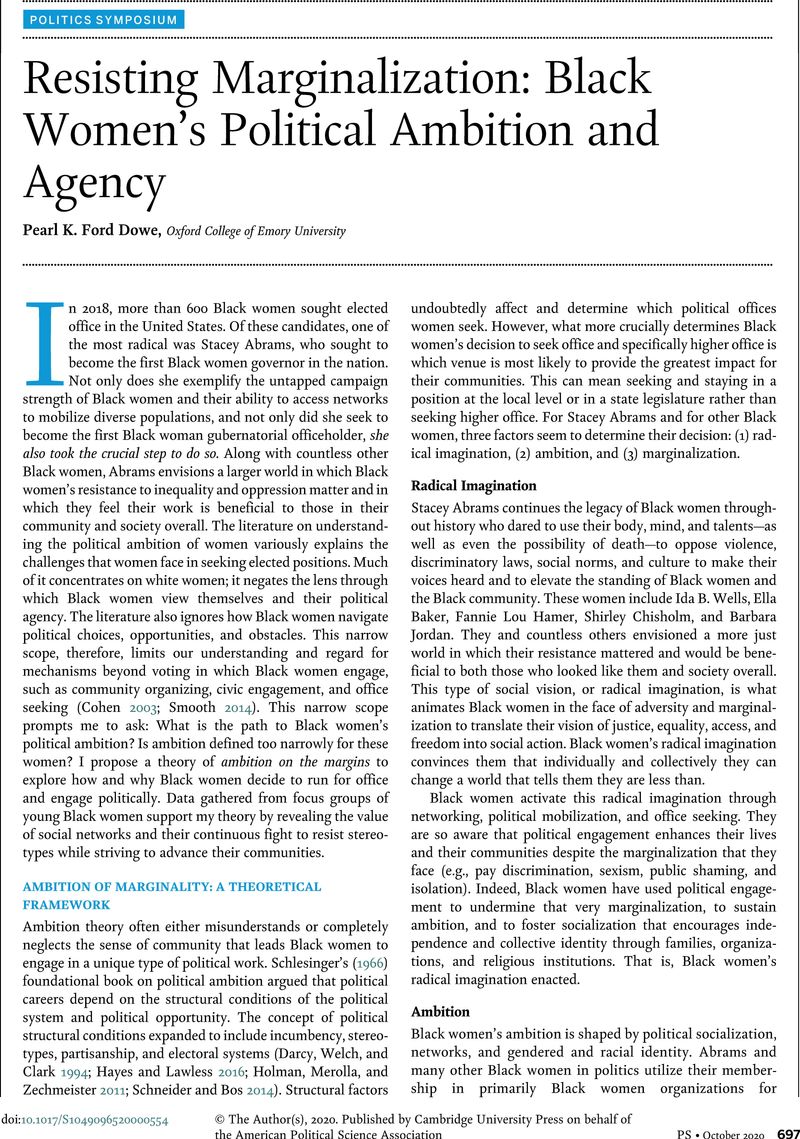Crossref Citations
This article has been cited by the following publications. This list is generated based on data provided by Crossref.
Genao, Soribel
and
Mercedes, Yaribel
2021.
All We Need Is One Mic: A Call for Anti-racist Solidarity to Deconstruct Anti-Black Racism in Educational Leadership.
Journal of School Leadership,
Vol. 31,
Issue. 1-2,
p.
127.
Ford Dowe, Pearl K.
2022.
The Community Matters: Finding the Source of the Radical Imagination of Black Women’s Political Ambition.
Journal of Women, Politics & Policy,
Vol. 43,
Issue. 3,
p.
263.
Keenan, Lisa
and
McElroy, Gail
2022.
Who wants women to run? an investigation of gender differences in patterns of support among Irish local election candidates.
Irish Political Studies,
Vol. 37,
Issue. 4,
p.
477.
Smith, Aidan
2022.
Galvanizing Grief: Black Maternal Politics, Respectability, and the Pursuit of Elected Office.
Journal of Women, Politics & Policy,
Vol. 43,
Issue. 3,
p.
347.
Liebenow, Hayley A.
Boucher, Kathryn L.
and
Cassidy, Brittany S.
2022.
Understanding Evaluations of Kamala Harris in 2020: Political Ideology Qualifies Perceived Communality Effects When Communal Cues Are Present.
Psychology of Women Quarterly,
Vol. 46,
Issue. 4,
p.
399.
Bejarano, Christina
and
Smooth, Wendy
2022.
Women of Color Mobilizing: Sistahs are Doing It for Themselves from GOTV to Running Candidates for Political Office.
Journal of Women, Politics & Policy,
Vol. 43,
Issue. 1,
p.
8.
Brown, Nadia E.
Clark, Christopher J.
and
Mahoney, Anna
2022.
The Black Women of the US Congress: Learning from Descriptive Data.
Journal of Women, Politics & Policy,
Vol. 43,
Issue. 3,
p.
328.
Means, Taneisha N.
2022.
Her Honor: Black Women Judges’ Experiences with Disrespect and Recusal Requests in the American Judiciary.
Journal of Women, Politics & Policy,
Vol. 43,
Issue. 3,
p.
310.
Wrighten, Jatia
2022.
Centering Black Women Political Elites, A Review.
Journal of Women, Politics & Policy,
Vol. 43,
Issue. 3,
p.
417.
Phillips, Christian D.
2023.
Nevertheless, He Persisted: White Men and the Links Between Incumbency and Group Descriptive Representation.
Political Research Quarterly,
Vol. 76,
Issue. 4,
p.
1691.
DeMora, Stephanie L.
Lindke, Christian
Long, Sean
Merolla, Jennifer L.
and
Osorio, Maricruz A.
2023.
The Effect of the Political Environment on White Women’s Political Ambition.
Political Research Quarterly,
Vol. 76,
Issue. 4,
p.
1987.
Felmlee, Diane H.
Julien, Chris
Francisco, Sara C.
and
Warin, Thierry
2023.
Debating stereotypes: Online reactions to the vice-presidential debate of 2020.
PLOS ONE,
Vol. 18,
Issue. 1,
p.
e0280828.
Brown-Foster, Walton
2023.
Identity Politics in US National Elections.
p.
19.
Gonzalez, Sylvia
and
Bauer, Nichole
2024.
Strong and caring? The stereotypic traits of women of color in politics.
Politics, Groups, and Identities,
Vol. 12,
Issue. 1,
p.
124.
Sommer, Udi
and
Franco, Idan
2024.
Trump’s African Americans? Racial resentment and Black support for Trump in the 2020 elections.
Politics, Groups, and Identities,
Vol. 12,
Issue. 4,
p.
921.
Grant, Rachel
and
Johnson, Benjamin K.
2024.
It All Begins With a Name: Examining News During the Ketanji Brown Jackson Judicial Nomination.
Journalism Practice,
p.
1.
Sanbonmatsu, Kira
Matos, Yalidy
and
Greene, Stacey
2025.
The Boundaries of “Women of Color”: The Political Implications of Non-Hispanic Whites’ Perceptions of Women of Color.
Journal of Women, Politics & Policy,
Vol. 46,
Issue. 1,
p.
55.



